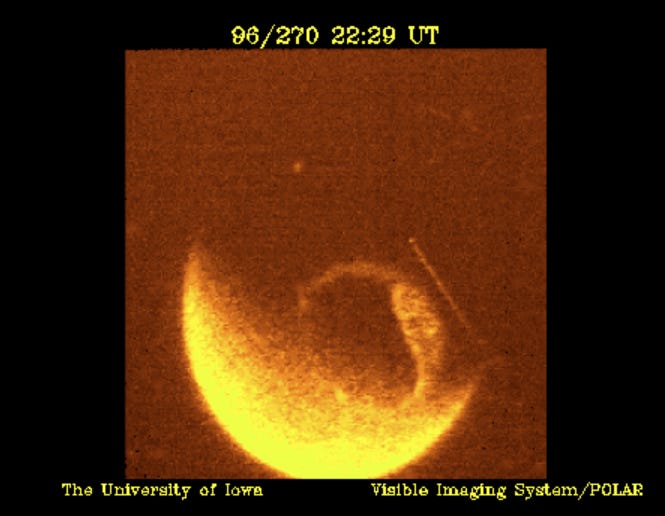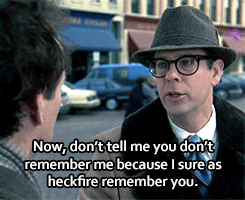Groundhog Day – The Small Comets Annual Return. 10 Million, 40-ton carbon-mantled snowballs a year disintegrate into water vapor in the Mesosphere and piston through the Stratosphere.
I have chosen Groundhog Day as a memorial to Professor Louis A. Frank and his discovery. Frank called the objects he discovered, ‘small comets.’ Small comets disintegrate in Earth’s atmosphere on entry and create clouds of water vapor that appear as ‘atmospheric holes’ (at least that is what Frank and his associates chose to call the spots in their images). The seasonal variation in the number of ‘atmospheric holes’ that appeared in Dynamics’ and POLAR’s images is unrefuted and unrefutable evidence that the small comets are not instrument noise, (image processing defects, i.e. TV snow). Their frequency would drop to almost nothing year after year, abruptly about the middle of November and wouldn’t start to pick up until after the middle of January. How could instrument noise create the same seasonal variations, year after year, using different spacecraft with different imaging instruments? It was around the first of February, forty-one years ago, Frank and his graduate students first started asking each other what to do about those spots in the images that were crashing the software. So, it’s Groundhog Day and the small comets are returning. Liturgical years help us remember, lest we forget. Reclamation is impossible if we can’t remember. Truthfully, there are at least a couple reasons why Groundhog Day works as a metaphoric memorial for Frank’s discovery. How should one think about Groundhog Day anyway?
Candlemas is February 2nd, pretty much exactly halfway between the winter solstice and the vernal equinox in the northern hemisphere. It’s the feast of Mary’s Purification and the presentation of the infant Jesus at the temple. Jesus is the light of the world, and the Catholics bless the candles for the coming liturgical year on this day. February was the time of the Roman Festival Lupercalia, a pastoral festival of purification. Lupercalia was also called, dies Februatus after the name of the instruments of purification, februa. The word, ‘leprechaun,’ evidently comes from Lupercalia, which itself is cognate with wolf. Imbolic, or Saint Brigid’s Day, is a Gaelic holiday held February 1st. Imbolic had great similitude to Lupercalia. The church in those early days made a virtue out of co-opting pagan holidays.
The Pennsylvania Dutch (Deutch) were the very early German settlers in Pennsylvania. Germanic folklore had the badger (German: Dachs) as one of the weather forecasting animals. The Germans had several proverbs about badgers, sunlight, and the end of winter. The Scots have a very old couplet, “If Candlemas is fair and clear / There’ll be twa winters in the year.” Plenty of Scots Irish settled early in Pennsylvania. They were intermingled with the Deutch. Finally, February is the end and the beginning of the farm year. The IRS makes farmers file on March 1 – no extensions either. Even today its customary for annual agricultural contracts to begin at the end of February – the same time as ancient farm/tenant/servant contracts annually were renewed. It makes sense, the old Roman New Year was March 1st. Farmers needed to get after it as soon as possible – but annually needed an answer to the question, “when, is too early?” Extra insight into the future is always a hot commodity. Even today, tax preparers have an easier time getting their farmer clients taxes filed when the weather keeps farmers out of the field.
Bet you thought of the movie, Groundhog Day, when you read my subtitle, am I right?
Perhaps you also thought about Punxsutawney, Pennsylvania, but again in context of the film. Certainly, you didn’t think about eating groundhogs, which is what the good citizens of Punxsutawney did back in 1889 when they first got to ‘boosting’ for their place in the sun. Don’t ask me about their groundhog punch, I only read as far as the groundhog banquet, which never caught on, because people don’t want to eat groundhogs. (Even if they do taste like chicken.) Metaphorically, the small comet flux is like groundhog punch, nobody wants to think about it.
Frank’s small comet discovery is an experimental certainty, a repeatable observation, a fact, the truth. Earth’s orbit around the sun is observed only through precise measurements that are counter-intuitive to the observed rising and setting of the sun. Like Earth’s orbit, the small comet flux is also observable only with precise measurements using specialized, digital imaging equipment aboard spacecraft. As the small comets disintegrate entering the atmosphere, the water vapor cloud they create blocks the ultraviolet dayglow emitted by Earth’s upper atmosphere. Frank’s instruments imaged the dark holes or spots in Earth’s UV dayglow. Galileo’s trouble with the church had everything to do with a meta-narrative getting contradicted, and nothing to do with his observations. As Galileo supposedly muttered at the end of his trial, Eppur si muove, “and yet it moves.” His inquisitors let him go – Galileo could believe what he wanted, as long as he didn’t talk about it. The atmospheric holes in Frank’s images and the plummeting pistons of water vapor in our upper atmosphere are still there. No one is talking about it.
Frank’s small comets, his forty-ton snowballs, are still infalling, ten million or so every year. The circumstantial evidence is still accumulating, trillions of tons of it on the moon and neighboring planets. There are now increasingly sophisticated instruments on spacecraft that can image the small comets and I am confident occasionally they do. These instruments are never used to confirm Frank’s discovery. I suspect most of the scientists operating those instruments have never heard of the small comet flux. The small minority that are aware, studiously avoid following up incidental observations of small comets because they fear contradicting the dominant progressive narrative.
The University of Iowa, where Frank spent his entire career as a tenured professor has expunged any mention of small comets from his CV and obituary. In the beginning, in 1986, Frank’s colleagues begged him not to publish his papers on small comets. They did what they could to thwart publication. Frank understood their sentiments, if not their actions, were concerned for his, and their reputations. Frank’s discovery was extraordinary and beyond startling. Four years later, the words in the subtitle of his book, ‘revolutionizes how we view the origin of… (more or less everything)’ appeared on the cover of the 1990 addition of his book, The Big Splash. The second addition, Cosmic Rain is greatly expanded and was published posthumously in October 2021.
Turns out revolutionizing how we view origins is not allowed. Frank spent the better part of twenty years answering every objection through the peer review process. He repeated the experiments with different spacecraft and different imaging instruments. No one found errors in his work. His opponents asserted over and over Frank’s small comets must be ‘instrument noise.’ Every time an outside researcher, like PSU’s John Oliverio, or Clayne Yeats, the science manager for the Galileo project, took Frank’s data seriously, they were able to corroborate their images with his. Their work was persuasive, but their peer-reviewing adversaries weren’t persuaded.
The movie Groundhog Day has the same conversion motif as Charles Dicken’s, A Christmas Carol. Phil Conners and Ebeneezer Scrooge are both very capable, but very unlikeable men. They are both without consort, but united in their subconscious regret about their solo status. Wealth, success, and achievement are disfiguring and base when a man is solitary and alone. The miraculous suspension of time is necessary for both men to examine themselves, their mortality, and their interconnectedness to others in their place and time – it’s the born-again thing. Jesus’ words: “He that loveth his life shall lose it; and he that hateth his life in this world shall keep it unto life eternal.” The enduring appeal of both Groundhog Day and A Christmas Carol is the motif of hopefulness that a man might escape himself and understand the truth about himself. Man’s selfishness is destructive. Self-sacrifice and love are the seed that holds the promise of redemption. Frank’s persistence was not self-serving, nor self-destructive, but it did wear him out. You could say he wore himself out for the truth.
Louis Frank was a giant in his field of experimental physics, but something of a Phil Conners in his personal relations. I’m guessing his struggle was real when it came to loving and caring for others, but there is no question Louis A. Frank loved the truth. The good old-fashioned truth, not his truth. A true alchemist, truth was what he was after. Truth is the only incorruptible element. For someone like Frank, who lived for science and sacrificed everything for his belief in its rules – it was self-sacrifice. The instruments of purification were the februa of peer review. It was a crucible, a refiner’s fire, a cross to bear, if you will. Frank would think it preposterous if you called him a prophet, but that honorific title is a good fit. What is a prophet? He’s a man that proclaims the truth. His message is tailored to suit Truth, not an audience. It was Jesus of Nazareth who said, “A prophet is not without honor, except in his own country.” Punxsutawney Phil is a prop, not a prophet, an actor in a show. As much as Frank loved his, “savage little game” of science, he was no gladiator. He was not in show business. In the end, truth was his cause and his god. He wasn’t for sale, no matter the cost, and he was faithful to the last.
Personally, I hold Frank’s church in low regard, too many of the congregants are hypocrites and unbelievers, and the liturgy of science is meaningless. Plenty of miracles are performed, but inside, there’s not much regard for the truth. But all churches tend to be like that. God be merciful to us – if we are going to change all the churches into theaters.
As for the forecast? It’s complicated. Always believe the sun is shining up there somewhere. Remember the promise of another tomorrow. And hold tight to this truth – only God knows the future. Who knows what we’ll discover in the new year? We’ll have to try and connect the dots.
I called it the progressive narrative. The experimental method, science, by its familiar name, has created a progressive motif in our collective imagination. Incrementally, experiments with matter reveal the truth about matter and mankind has been quick to use the experimentally revealed truth about matter towards improvement. Infant mortality reduction is a great illustration. In 1900, in the US, twenty-five percent of all children born, died before their sixth birthday. The progress narrative is, ‘medical science works.” Almost everyone takes their children to the doctor/hospital because no one wants their baby to die… die like they used to in the past. And most parents don’t want to have their children taken from them for not taking them to the doctor. Believe the narrative, or else. The experimental method of inquiry drives both our epistemology and our ontology. Science has become the global meta-narrative. Progression may not be predictable, (pandemics, etc.) but the vector is determined. The forcing is random, but the direction is forward, and the result is progress. And it’s the case in all physical sciences, not just medical science. Uniformitarianism in geology and evolution in biology are progressive creation narratives. Both of these narratives are dependent on deep time. Both theories need an incomprehensibly long timeframe for their random, undirected, progress to be believable. Without deep time the progressive creation narratives are unbelievable. Frank’s small comet discovery forces us to reconsider deep time and our creation myths. Science is having no part of it.




